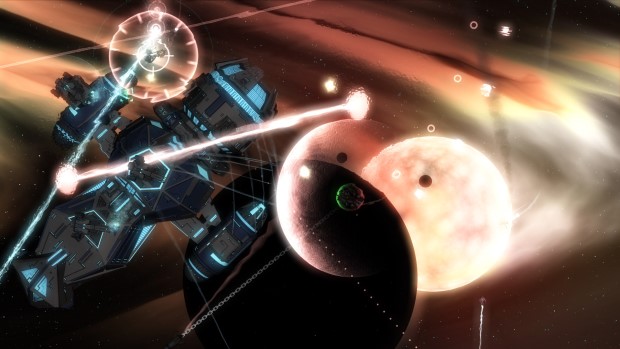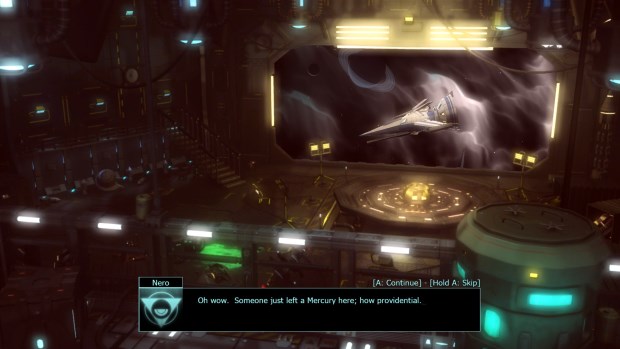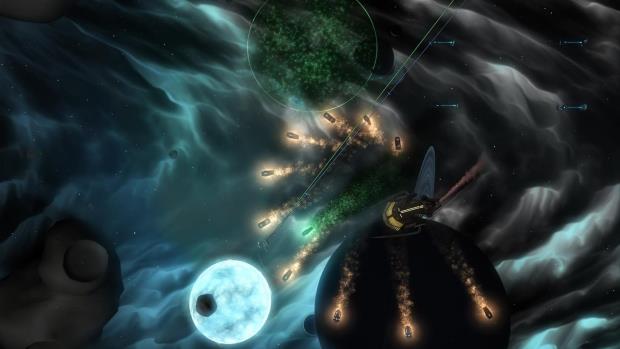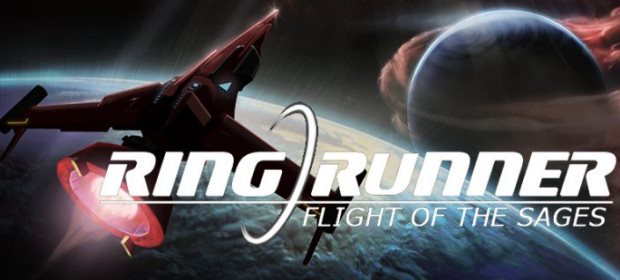Have you ever wondered what the arcade classic Asteroids would have been like as an epic role-playing space simulation? If so, Ring Runner: Flight of the Sages is the game you’ve been waiting for. Considering that it’s an independent title put together by a first-time development team consisting of two brothers, this new Kickstarter title brings a lot of interesting features and ideas to the table, even if it might not blow you away.
Ring Runner is a story-driven space combat title that begins with that well-worn hook whereby you wake up on an operating table with amnesia. With the help of a new brain implant that speaks to you from inside your head, you quickly escape and begin to learn about the world of Ring Runners (a kind of mercenary), scrap hunters and Sages. The campaign is weighty, allowing for well over twenty hours of play. There are no real cutscenes to help move the story along, with exposition taking place mainly through conversation between you and your brain implant. The game is based on a novel authored by the developers, but strangely doesn’t offer a particularly deep story to follow as you go along.

As you progress further into the game the galaxy map opens up and you can choose your own path, tackling missions as you wish on your journey to becoming a powerful Sage. The main issue with the story is that whilst the tutorial is quite tight and structured (and really does teach you more or less all you need to know about how to play Ring Runner) the rest of the game lacks any real direction and it’s easy to become a little disengaged. The story is only really there to create excuses for the next space battle, not to captivate the player. The tutorial is also over-long, so you may be chomping at the bit to get started. It’s likely to be particularly irritating if you come to Ring Runner expecting a sprawling space epic.
The gameplay is where the comparisons to Asteroids emerge. Rather than playing from a cockpit view and using yolk-style controls, the ships in Ring Runner (from junky trash transports to speedy fighters) control more like tanks. You simply use thrust and aerobrakes to speed up or slow down, and left and right to alter your trajectory rather than turn. This means you can accelerate in one direction while you fire backwards. Momentum will carry you forward, although you can also make use of special skills to manoeuvre more swiftly or to fire your many weapons.
You have to get used to using the inertia of your ship to control flight while you focus on how best to attack and defend. Most skills have cool-down times, meaning you have to manage your weapon usage, shields and hull energy, while keeping an eye on the energy cells that power your ship. This can all seem a bit confusing to begin with, but once you become accustomed to it the actions become second nature and you can work out winning tactics.

After you have worked your way through the extensive tutorial, you will have built up quite a number of different ships to fly – and now you can begin to customise your rides, too. To begin with, there is a variety of different ship classes, such as Grapplers which can grab objects and enemies alike, Fighters that are nippy in a fix and Arsenals that are powerful but slow And then you can apply all sorts of extra items and upgrades, making small changes and perfecting them to suit your play style or the mission objectives as well as you can.
Considering that Ring Runner offers you little structure once you get to this point, knowing which ships and combinations will work best is very hit and miss. This is compounded by the uneven feel of the mission structure, whereby short easy missions will follow long, intense ones. The difficulty is therefore all over the place, no matter which difficulty level you pick at the start. With a complete lack of mid-mission saves or checkpoints, you could invest a lot of time into a level only to have to begin it all again. There is a selection of co-operative and competitive online game modes, and these can be pretty fun when played with friends, but don’t resonate to the point where you will keep coming back to take Ring Runner online.
Ring Runner certainly won’t grab your attention with its rather minimal and old-school visuals, either. The top-down view lends itself to a lack of detail, and while there are some interesting particle and exposition effects, the game is pretty visually unimpressive, and the HUD often becomes a little messy on the screen and can get in the way. The sounds are also minimal, limited to explosions and atmospheric music that do little to make Ring Runner stand out from the crowd.

VERDICT: Ring Runner is fun, different and challenging – but unfortunately it lacks a little accessibility. It’s clearly a Kickstarter title, from the uneven level design down to the basic visuals – but it also has a strong gameplay engine at its core. This game won’t be to everyone’s taste, but will meet the needs of PC gamers looking for old-school space fights. There is clearly the demand for it as Ring Runner met its funding targets, but it remains to be seen how much it will sell outside of its existing supporters.

DECENT. A 6/10 indicates that, while this game could be much better, it still has a fair amount to offer the player. It might be an interesting title sabotaged by its own ambition, or a game denied greater praise by some questionable design choices. Don’t avoid it outright, but approach it with caution.
Review code provided by publisher.






